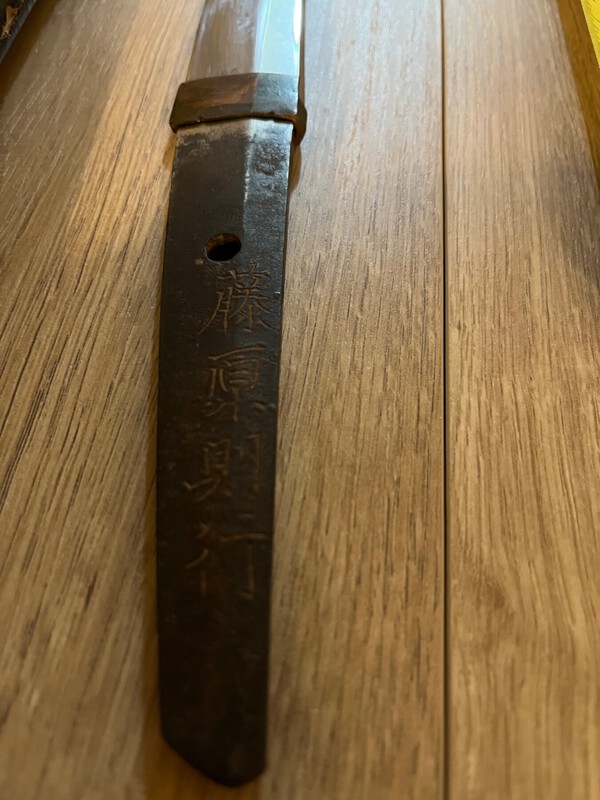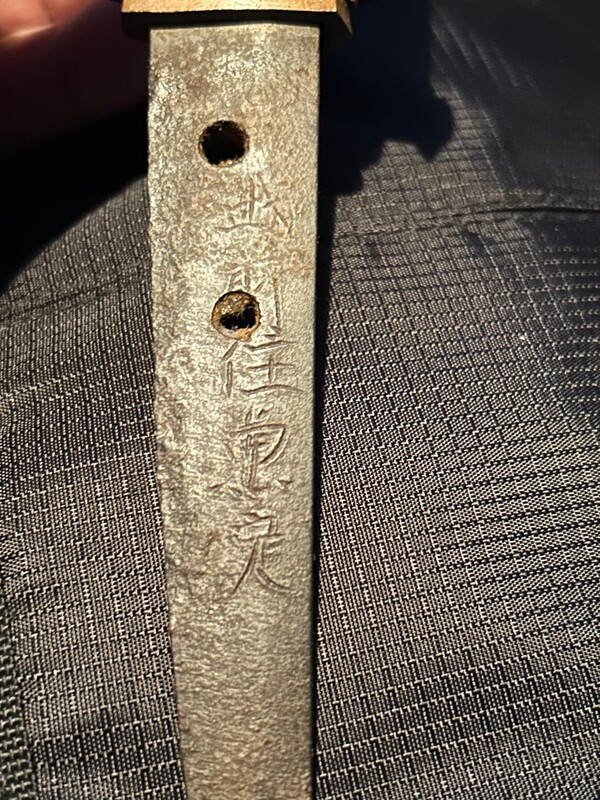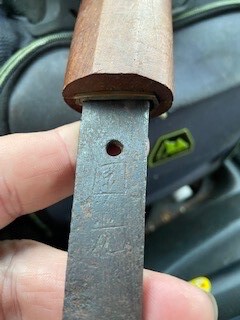
Apercus
Gold Tier-
Posts
118 -
Joined
-
Last visited
-
Days Won
1
Content Type
Profiles
Forums
Events
Store
Downloads
Gallery
Everything posted by Apercus
-
-
I have a juyo Ichimonji tachi with vibrant utsuri appearing in an area that has .45% carbon content. I tend to think your conclusion that .45% carbon content steel can’t produce utsuri is incorrect
-
The only way to determine answers on this subject is through trial and error error controlled experimentation. Results provide bits of information. A lot of trials and results eventually define the science. Everything else is speculation and should be treated as such.
-
As a side note, Howard Clark produces Japanese styled blades in a process that maximizes banite formation instead of martensite. The process allows for an edge almost as hard but greater toughness and resistance to breaking overall.
-
I believe there are several effects that are called utsuri. The description given by Yoshindo Yoshihara I believe is describing the formation of banite in the microstructure. Banite forms at a different temperature range than martensite. It is almost as hard as martensite but is much tougher and resistant to cracking. It is very desirable from the viewpoint of structural integrity. I believe many older blades were made without the use of clay. I suspect a large bar of iron was heated to a suitable temperature and the edge of the blade to be heat treated was placed against it to allow heat by conduction. I don’t see any other simple way to achieve a controlled differential application of heat on a long slender sword without modern technology. I have experimented with this and have produced “utsuri” similar to what I see on older blades. Not every steel will produce utsuri. As Rivkin mentioned, different steels have different thermal conductivity characteristics. It is difficult to produce utsuri on most modern steels, especially with high carbon content or alloying elements. I find that tamahagane with a medium carbon content works better for producing utsuri. I did X-ray diffraction analysis on a mid kamakura tachi with vibrant utsuri and found the core steel was high carbon (.7%) while the exterior layers were mid range carbon content (.45 % to .55%). I haven’t done an exhaustive study of the effects called utsuri. I don’t have the samples, time, money, energy, etc. These are just my limited observations from several years ago, so take that into account.
-
A friend sent poor photos of a wakizashi someone gave him to practice sharpening with. He has forged and sharpened blades at the blacksmith shop in the past. Luckily after looking at it he decided it might be something he has no business doing anything to it. I don’t have my books with me but thought I might ask if anyone can make out the mei well enough from the poor photos to translate. I’ll help him know what he has and how to care for it or how to get it in the right hands of someone who will care for it if he wants to sell. The photos are a little out of focus and the characters are hard to see well.
-
Thank you once again
-
I haven’t gotten the province yet. I think it’s followed by “ju Kanesada”. I’m trying to figure out which Kanesada this katana proposes to be. Any help is appreciated. I’ll send photos and description this weekend.
-
Thank you
-
-
There are many books and recipes for producing patinas on metals. I have several. Anyone with the time and resources to allow for experimentation should be able to produce an acceptable patina. Luckily, most who produce artificial patinas are not patient or fail to put out the effort to do it well. If you find a technique that works well please don’t publish it. We don’t want to educate grifters.
-
It was quit a few years ago
-
Nice to see the photos. The display I saw at the V & A museum was dark and afforded no real view of anything.
-
I don’t disagree with any of the posts here. All seem to be good ideas and well thought out. I haven’t seen a thorough analysis of the metallurgy of utsuri. It would have to be comprehensive because not everything we call utsuri is the same micro structure or at least that’s my opinion. Banite formation is one of the results that we call utsuri. It forms at a different temperature than martensite and can be produced without clay. The heat is introduced at the edge of the blade and is not allowed to spread across the full width before quench. Imagine holding a blade edge against a heated block of steel to transfer heat to the blade. Quench before the heat travels uniformly across the width. The band of banite will appear seperated from the martensite. I have found that not all steels will produce this effect. Low allow and mid to low carbon content works best for me. I haven’t done anything comprehensive in testing many allows so I’m speaking from limited first hand experience. Think about the effect you see on a blade damaged in a fire and then reheat treated. The whitish band between the nakago and the blade which is an indicator of reheat treatment is the same thing as some of the effects we call utsuri. if you want to test this yourselves take a bar of low allow medium to low carbon steel (something like 1045 steel) and heat the tip of one end. Quench and then polish it.
-
Thank you. These fittings were on a wakizashi I recently acquired which is signed “Bishu Osafune Morimitsu”. Unfortunately one of the previous owners must have allowed children to play with it and cut things. I’m hoping it will be found in good enough shape for polish and doesn’t end up as another sad victim of abuse.
-
-
View into Blade Construction
Apercus replied to Bruce Pennington's topic in General Nihonto Related Discussion
I agree with Jean’s assessment of the process but would add that in the process of folding each individual steel type they do not typically continue until the steel is homogeneous. You would not see the visual effects of layering such as Itami if the steel is homogenous. The boundary layer between folds has silicon which distinguishes the layers. The presence of distinct layers adds mechanical advantage by increasing resistance to crack propagation. There were also other types of construction that are not shown in the chart such as san mai. Close examination of blades by Cyril Stanley Smith have shown that some smiths alternated steel types (carbon content or composition) before repeating the folding process, thereby producing an effect similar to “pattern welded” blades common today. I have one of these in my collection. I would not be surprised to see almost any variation of structure. As mentioned, skill level of the smith is probably the most important variable in how the sword will perform. -
You may be right. There are other ways to produce it that are less wasteful and difficult. It’s just not produced by twisting the bar.
-
Twisting the sunobe does not produce ayasugi hada. It’s usually created by cutting, filing, or grinding groves in both sides of an oversized bar while alternating the locations between sides. The groves would be deepest at the edge and more shallow towards the mune. The bar would then be forged flat into the sunobe. It’s a common technique used be knife makers today. Twisting a bar produces a very different effect that looks nothing like ayasugi hada.
-
Just curious about the signature. I don’t have enough reference examples for this one. It’s an old tanto (somewhere between 1300s to 1500s. I won’t have good photos until this weekend. The basic dimensions are as follows: hirazukiri shape, uchizori blade, nakago has no sori and ends in a “flattish” kurijiri motohaba 1” sakihaba 3/4” nagasa 28+ There is utsuri and the hada looks very interesting (Itami and mokume) The hamon is shallow gunome and close to the edge. Anyone have reference examples of the signature or thoughts? I’ll get it to shinsa and perhaps polish eventually. Photos will follow this weekend. Shannon
-
Looks like an interesting article. Thanks for the reference
-
Kirill’s analysis seems very reasonable and astute. I think any smith would readily see the problems and unnecessary efforts associated with producing a cast blade. For all the effort you end up with a fragile thing. The earliest “steel” was actually forged iron that had carbon introduced through carburization. it’s a simple process and requires much less effort and resources. The iron blade is simply coated with organic based materials, placed in an iron container and heated to a red heat. The longer it is held at heat the deeper the carbon penetrates the iron. If you hold it long enough the carbon will penetrate as much as an eighth of an inch. You then have a “steel” edge that can be heat treated. This technology was around in Europe at least 1500 years ago but it’s hard to believe that almost any smith working with forging iron would not have “discovered” the effects in any era or location. It’s almost unavoidable if you work in a forge very much. The initial primitive refinement of ore into iron is almost always in the form of a “lump” or a crude cast form. There will always be a need for forge work to establish the final shape and remove impurities. That approach has been well documented as being used in cultures across the globe. I would be surprised to see any real evidence of a “cast iron” ancient sword. ( carbon content >3%).
-
There are many good articles on archeotechnology of early iron production all over the world. I’ve read several detailed analysis of ancient eastern (Chinese, Japanese, Indonesian, etc.) I’ll see if I can find some of them and post links when I get time. There is an annual publication which is a collection of papers on ancient metallurgy. I will try to find copies of the ones I have. A simple internet search on the subject would reveal many articles. Ancient forge work was often far more sophisticated than we tend to give credit for. Like any other time in history there was exceptionally good techniques made by isolated smiths concurrently with poor work in other areas. It’s a fascinating subject.





















